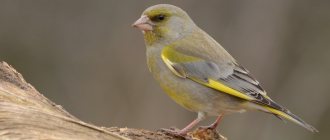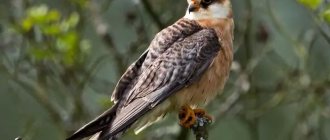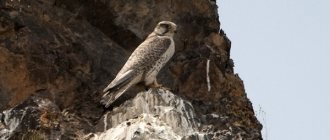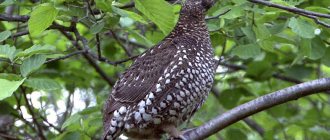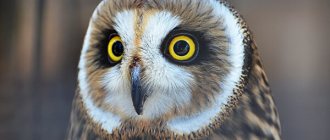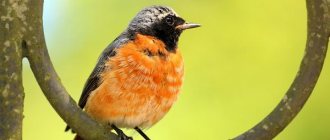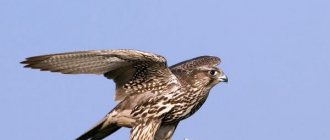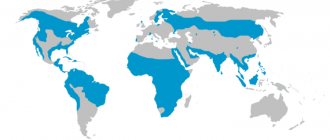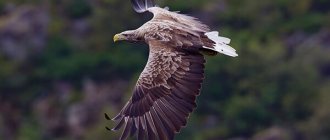- October 12, 2019
- Miscellaneous
- Just a journalist
Every day the number of people who want to buy birds of prey to keep at home is increasing. Most often, small falcons are kept with hawks and owls. When deciding to purchase this kind of feathered friend, you need to understand: owls, eagles, and hawks are not considered domestic birds. In addition, their presence in the home implies a significant threat to well-being.
The greatest difficulty lies in the fact that birds are never completely tamed and remain untamed. They find it difficult to cope with their fear of people. Upon closer contact, you can notice a defensive reaction in the falcon; for this reason, it can use its claws and beak. It is possible to raise a wild chick, but it will still remain wild to the end.
Is it worth keeping a falcon at home?
Buying a carnivorous bird is a thorough and responsible event. You need to familiarize yourself in detail with the description of the falcon bird with all the nuances.
A person must love animals, without this it is impossible to create favorable conditions for the development and long-term existence of his pet. You will need to give most of your time to the bird, sacrificing your time. If you decide to acquire a winged predator, you need to think about the pros and cons. It is worth focusing on negative factors.
How to choose a falcon?
If you have thought it over and firmly decided to have a falcon as a pet, then it is best to purchase a chick. The baby will get used to you from birth and will make friends with you. You can find a down chick at the age of two weeks in a falcon's nest. But you should know that the cub will squeak loudly - asking for food. You can purchase a falcon chick in specialized places.
You should not purchase a predator as an adult. The process of getting used to and learning will be longer and more difficult.
Against the bird of prey at home
The primary disadvantage is that the falcon is a predator and must eat rodents and small birds. Meat purchased at the mall cannot guarantee the nutrition you need. Birds may have digestive problems. If there is no uneviscerated carcass in the diet, your pet will not have the necessary vitamins and minerals, as well as the required amount of calcium and magnesium, which can cause illness. The carnivore's plumage deteriorates due to improper feeding. Expenses on food will need to be significant, because poultry needs quite a lot of meat.
The next disadvantage is bird droppings. A falcon can “shoot” up to two meters in length just by lifting its tail up. As a result, everything in the room will be unkempt, dirty and will acquire an unpleasant aroma.
general characteristics
Falcons are birds of prey that are found throughout the world except Antarctica. The word “falx” (sickle), characterizing the shape of the wings during flight, served as the basis for the name of the bird (“falco” in Latin). One of the falcon subspecies, the peregrine falcon, is considered the fastest creature on planet Earth. It is capable of reaching a fantastic 320 km per hour.
Even in the times of Kievan Rus, the peregrine falcon was called a falcon . Later, the name “falcon” was given a broader meaning, referring to the entire falcon family. But even today, most people identify the concept of “falcon” with the peregrine falcon.
The falcon family also includes gyrfalcons, laggars and saker falcons.
- Hobby is an insectivorous member of the family, small in size, with a narrow, elongated beak;
- The kestrel is a rodent hunter.
When describing the bird, one cannot fail to mention that specially trained falcons, most often peregrine falcons, have been used as hunting birds since ancient times. Falconry has very ancient traditions.
The bird's beak is quite small, but very strong. There is a sharp tooth at the top. The large wings reach the tip of the tail, although the tail of the bird is quite long. The second, longest feather is the flight feather. But the wing becomes like this with age. In chicks, all feathers have the function of flight feathers.
Did you know? The peregrine falcon is considered the fastest creature on the planet. But this is true for movement in general; the falcon develops a speed of 90 m/s when diving. In straight horizontal motion, the swift is ahead of it at a speed of 110 km/h.
If you see a bird soaring high in the sky with open, rather wide wings, most likely it is a falcon that has not yet reached maturity. Such wide wings somewhat hinder the young predator, but thanks to them, he quickly learns to fly, so that he can subsequently do it faster than anyone else.
How does poultry domestication occur?
Falcons, photos of which are presented in the article, have been tamed by people for a very long time. Often they remain unbridled, they fear a person all their lives and do not trust him. For the purpose of self-defense, the predator often releases sharp claws and also uses its beak, which can harm the owner.
Often, contagious diseases and parasites are detected in carnivorous birds, for this reason it is necessary to constantly visit a veterinarian who practices directly in treating birds, but not animals.
An important aspect is that the falcon must have an equipped cage. You can also make an enclosure for a predatory pet. There are reasons for this. Your home will regularly become unkempt, with dirt visible everywhere and feathers flying around. In such an environment, unpleasant moments may arise, for example, a falcon will get tangled in a curtain and tear it, or bump into a window frame and harm itself.
The place where the birds will sleep should be free of any drafts. And at the same time the bird will ask for air. High humidity and heat negatively affect her well-being.
Description
The head is flat with large shiny and moving eyes, the neck of predators is short. Beak with a sharply protruding tooth on the upper jaw. Long and sharp wings sometimes reach the end of the tail, which in falcons is relatively short and slightly rounded. The length of the female's wing sometimes reaches 37.8 cm, and that of the male - 33 cm. The falcon has a powerful body. The predator has a broad chest, strong shoulders, and well-developed fingers. Developed hard “pads” on the inner surface of the fingers help to hold prey. The bird reaches its full weight at about one year of age. Coloration varies significantly depending on the area. It also depends on age: young birds are different from old ones. There is a slight difference in color between males and females. Males are usually lighter than females.
Nuances of maintenance and care
It is necessary to take into account that birds of prey such as eagles, falcons and owls are not pets, for this reason it is not recommended to have them. If you nevertheless dare to take such a step, it is necessary to provide your feathered pupil with safety and comfort in unusual circumstances for him. The bird needs to install an aviary with dimensions of no less than 6 × 6 meters and a height of approximately 4 meters. It is recommended to make crossbars in the aviary where the falcon will sit. The roof must be closed from the weather. It is necessary that artificial conditions remind the falcon of its natural environment.
You can build a nest for the bird where it will lay eggs. Large branches tied together with wire are used to build nests. It is possible to insert thin branches. The bird will use them for curling without resorting to the help of others.
We should not forget about constant cleaning in the cage or enclosure: wipe and wash. There should always be a bowl of clean water inside the cage. You can put a bathing suit in the falcon cage. In addition, the cage must be constantly illuminated; only owls like a lack of lighting.
Predator feeding at home
For proper digestion, the falcon needs to be given small bones and feathers in addition to fresh meat. The bird regurgitates these remains (pellets) hours after feeding. The pellet is an essential component of the digestive activity of falcons and is of great importance for the stomach and the body as a whole.
During feeding, the falcon should be observed, namely, how the predator drops the pellets, whether there are any bloody inclusions or an unpleasant odor in them. If such signs are present, your pet should be taken to a veterinarian.
In a typical wild environment, the falcon eats rodents, birds, toads, fish and snakes. At home, the predator is fed with mice and small birds. Food for a predatory pet can be bought at a pet store, but catching it without the help of others will also not be difficult.
How many times should you feed a falcon?
The falcon's feeding should follow a schedule in accordance with its age:
- from birth - 5-6 times a day;
- from 2 weeks - 3-5 gas per day;
- from 4 weeks - 2-4 times a day;
- before fledging - twice a day.
Before feeding the bird, you need to make sure the food is of good quality. The food must be carefully examined for any defects. In case of hesitation and doubt, there is no need to feed food to birds; they have every chance of becoming infected. The smallest falcons need to be given small pieces of meat, pre-soaked in a saline solution. This will mimic the mother's saliva and may also help the chick's digestive system. Don't forget about the puzzle. To do this, you should provide the chick with bones and feathers. The falcon will regurgitate the lumps that have formed in the stomach, emptying the stomach. Food fragments should not remain in it for a long time. Subsequent eating should be done only after the pet has thrown off the pellet.
Mice can be used as daily food. Quail has optimal value. However, a predator should be accustomed to them from a young age. It must be remembered that problems with the pellet can cause many serious diseases.
Appearance
About 40 species of falcons live on Earth; they are divided into three types according to their external characteristics and hunting methods. Below are the characteristic features inherent in most representatives of the species:
- body length - 40-50 cm;
- wingspan - 90-120 cm;
- tail - 13-19 cm;
- paws - 4.5-5.5 cm;
- wing chord - 27-39 cm;
- male weight - 0.65-0.8 kg;
- female weight - 0.9-1.3 kg.
The body is predominantly covered with dark gray plumage; the color contains triangular patches of a darker shade.
The belly and part of the chest (below) are pale yellow in color, with stripes of a darker tone; there are also spots on the black flight feathers. The top of the head is black, under the eyes there are elongated spots that look like whiskers and are called accordingly. There are over fifteen subspecies of falcon, which differ in size, color and other features characteristic of each type of bird.
Did you know? About 20% of birds living on the planet become prey for peregrine falcons.
Three of them are found on the territory of the former USSR:
- ordinary;
- Caucasian;
- tundra.
How to train a falcon?
The main purpose of a bird like a falcon is hunting, which is why it is usually purchased. The hunting sense of a bird is determined by genes; there is no hiding from it. If you do not plan to go hunting with the bird, you still need to train and educate it, otherwise the falcon can simply wither away. His strength and power must be constantly given an outlet.
You should not get a bird of prey until you have at least the least amount of knowledge about the falcon and handling it. Lack of awareness can cause the death of a bird. Don't rush, turn to professionals for support. You need to acquire as much data as possible on this subject. Give the bird a chance to adapt to new conditions and atmosphere. Let the falcon live surrounded by new people; it needs time to get comfortable.
If you properly train your falcon, you definitely won’t need a weapon when hunting.
Bird Owner's Encyclopedia
Originating about 5 thousand years ago in India, falconry quickly conquered the world, and the “sport of kings” reached its peak in the early Middle Ages. In Europe, falconry was widespread: it was a subtotal hobby of both feudal lords and commoners. There was a special table of ranks that prescribed who should hunt and with what bird. In England, stealing or killing someone else's falcon was punishable by death. To this day, sayings attributed to the eastern conquerors have been preserved.
“Falconry is the sister of war,” said Genghis Khan. Batu allegedly argued that only hunting with a bird can bring the highest pleasure to a man. Already in the 10th century AD. The chronicle mentions Prince Vladimir, who “... catches hawks and falcons,” but Russian princes seriously became addicted to “red fun” during the time of the Golden Horde. History knows only two great kings - great falconers. Genghis Khan's hunts, involving hundreds of birds and thousands of dogs, were enormous and majestic. Many hundreds of birds were kept under Ivan IV the Terrible - they even took the road tax from merchants in pigeons for falcons. But they were not destined to go down in history as royalty, who were true masters of falconry. The first of the great falconer kings was Frederick II of Hohenstaufen. He left a fundamental guide to falconry with unsurpassed ornithological observations, “De Arte venandi cum avibus” - “The Art of Hunting with Birds” remains an anthology, a genuine ornithological encyclopedia, on which many generations of falconers were brought up. The second great king-hunter was Alexei Mikhailovich Romanov “The Quietest,” the father of Peter I. Alexei Mikhailovich ruled as a pious, pedantic bearer of traditions, but the first manufactories in Rus' appeared under him. Throughout his life, the king’s true passion remained “bird fun,” which he indulged in, according to contemporaries, often to the detriment of state affairs. In addition to special trips, the tsar and his retinue also hunted on the way to a pilgrimage to Sergiev Posad, Kolomna, and the Savvino-Storozhevsky Monastery. He founded road palaces and country residences in his favorite places.
Being a romantic and possessing a poetic gift, Alexey Mikhailovich created a set of regulations for falcon service, which is, on the one hand, a set of formal rules of conduct for falconers, and on the other, a lyrical work of art that was included in the classics of ancient Russian literature: “... the flight of a high falcon is red-eyed and joyful.
This great amusement calms the hearts, the glorious bird’s prey amuses...” The repeatedly quoted “Foreman of the Falconer’s Path” has been alive for the fifth century. In Rus', the traditions of falconry have long been revered. One of the most revered saints is St. The martyr Tryphon is usually depicted on icons with a white gyrfalcon on his hand. There are also many places that keep in their names the memory of historical events related to falconry. These days, falconry around the world is experiencing a period of renaissance. Due to its greater environmental friendliness compared to gun hunting and incomparably less damage to nature, falconry is finding more and more supporters in our industrial society. There are many sites on the Internet (and their number is constantly growing) dedicated to falconry. In Russia today, ancient traditions are continued by enthusiastic falconers. Not far from the Moscow ring road is the former Trubetskoy estate - Znamenskoye-Sadki. It received its name Znamenskoye in honor of the wooden Temple of the Sign, erected in 1687 on the lands of the former owner - boyar Nikita Semenovich Urusov. On the territory of the estate, surrounded by hundred-year-old oak trees and velvety green meadows, there is now a research institute for nature conservation, and among the apple orchard of the estate there are aviaries with birds of prey: falcons, eagles, hawks and owls. In May 1996, the first chicks appeared here. The Russian Falconry Center
is one of the divisions of the institute, and its most important tasks are the revival of Russian falconry and the breeding of rare species of birds of prey, such as the peregrine falcon. This beautiful, noble bird also has a second name - the Russian falcon, but unfortunately, several decades ago it disappeared from most of the European territory of Russia as a result of the thoughtless use of chemicals poisonous to all living things, such as DDT. Currently, the Russian Falcon Center is successfully conducting a program for the reintroduction of the peregrine falcon - the release of birds into the wild. In 1996, on the territory of the main complex of Moscow State University, a release box with seven peregrine falcon chicks was installed on one of the roofs. Using a special method, without direct contact with humans, the birds were accustomed to their surroundings and at first, until they were able to hunt on their own, they were fed by the staff of the falcon center. In the future, young peregrine falcons have mastered the surrounding territory and there is hope that they will return to familiar places after wintering in Africa. Other successes of the center include the appearance of Saker falcon chicks already in the first year of working with birds and the rare case of breeding two chicks of a bald eagle, which is familiar to most people as a symbol of America or from the label of White Eagle vodka. All these programs will remain priorities in the nursery’s work in the future. In the future, it is also planned to create an ornithological park and a show with birds of prey on the basis of the Russian Falcon Center.
When should falconry not be practiced?
Falconry is a wonderful sport, but it requires a lot of time. If you lack the desire and time, it would be better not to engage in this sport at all. If you are one of the impatient people, then this type of hunting is not for you either.
Falconry should not be practiced if the falcon was purchased as a poultry. Also, fishing is not suitable for those who took the bird to show off. You can't just lock a predator in a closet when you've had enough of it. Despite the commitment and time spent, the reward in the end will be worthy.
How to tame a falcon at home?
- You should not engage in training without experience, special courses and a mentor. No matter how much time you spend training a falcon, there will still be no result. In addition, human inexperience can lead to the death of a falcon. Remember, only a mentor will tell you exactly how to tame a falcon.
- You should read specialized literature. Then the falcon's training will be as simple and easy as possible. You also need to buy equipment.
- You need to find a mentor who will share his experience in training falcons and teach everything necessary.
- The bird should be kept in the house, close to you, for several weeks so that it gets used to it.
- The falcon should be trained to fly up to the glove on the fist. When the bird learns and gets used to it, you can show it the bait.
- Achieve long flights. If the bird does not listen, then the bait should be removed.
- It is necessary not to let the falcon get bored and sometimes allow it to catch bait.
- There is no need to stop training a predator, even when the bird has already become accustomed to humans. A trained falcon needs daily training.
- The bird must be provided with good quality food. The menu should be varied. It is best to start giving your falcon quails, which are very nutritious, from early childhood. Mice are also an excellent food option.
- You need to take care not only about how to tame a falcon, but also about cleanliness. A bird of prey needs to be kept in order regularly. Dirt can lead to serious illnesses.
- It is absolutely not a good idea to let strangers care for your falcon. You should also not leave your pet in the care of people who do not know how to tame a falcon.
- Periodically, but not constantly, give the bird some treats when you want to get closer to it or move it. This will help in taming the falcon. Encourage the falcon to stand on your glove for a treat if it is well tamed. However, this should not be done in the initial stages of training.
- Teach your winged friend to certain things, such as a car and a dog, so that he is not afraid of them. Of course, something can scare the predator, but he will become more restrained.
- If for some reason you have concerns about releasing the bird, then there is no need to do so. Due to some distracting and interfering moments, you may simply lose your beloved pet. It will be impossible to return her.
Spreading
True falcons live all over the world, except Antarctica, being a cosmopolitan genus. They are found more often in open areas or alternate between forest and plain areas. They can also be seen near cliffs and cliffs. If people’s attitude towards them does not promise danger, then they settle near anthropogenic landscapes, even in cities.
Different species occupy different habitats. The gyrfalcon prefers northern countries, often living near the ocean, in the tundra, where there are many bird colonies in rocks. The peregrine falcon migrates, visiting Africa, America, Asia and Europe during its life. Kestrels live in New Zealand, New Guinea, New Caledonia, Madagascar and Mauritius, Seychelles, Australia, the steppes and semi-deserts of America and Eurasia, and African countries.
Hobbies are found on the islands of the Mediterranean Sea, in Japan, Indonesia, on the Kuril Islands, Sakhalin, in New Guinea, in Australia, in African countries, on the coasts of the Mediterranean Sea - in Tunisia, Algeria, on the coasts of the Atlantic, on the Arabian Peninsula, in Finland, Norway , Sweden. Other representatives of the genus can be found in Canada, New Zealand, Australia, New Guinea, South America and the USA.
Laughing falcons live in the Amazon forests and also occupy habitats from southern Mexico to Uruguay and northern Argentina.
Forest falcons are found in the humid tropical regions of Central and South America.
American pygmy falcons live in the pampas and semi-deserts of Northern Argentina.
Lesser falcons are inhabitants of semi-deserts and dry savannas of northeast and southwest Africa, as well as areas with sparsely growing trees in Southeast Asia.
Pygmy falcons, or tiny falcons, are sedentary birds that live in the tropical forests of Southeast Asia, from Northern India and Southeast China to the Philippines and the Malay Archipelago.
Warnings
- You should not scream or get angry in front of the bird. She will develop fear and fear towards you.
- Don’t brag to others and don’t show photos of the falcon left and right. The bird is, first and foremost, your friend.
- Try to avoid mistakes in relation to the predator, be careful. Every mistake can be costly.
- Give the bird enough attention and talk to it.
- Do not keep her in a cage or enclosure all the time.
Never forget that your pet is a falcon. If you take this responsible and dangerous step, you must follow all the recommendations, be theoretically and practically savvy in the question of how to tame a falcon.
Habitat
The bird is very strong, among birds few can compete with it. Favorite habitats are steppes and semi-deserts. Although they live almost everywhere, except for the North and South Poles.
In Europe, birds live in the mountains, nesting on steep cliffs that are almost inaccessible to pedestrians. In winter, they move closer to bodies of water, hunting waterfowl. Only young people fly to warmer climes; mature individuals remain at home for the winter.
- The gyrfalcon prefers to nest along northern rivers. It can be found almost throughout the entire territory of the Eurasian continent.
- Peregrine falcons are nomads and can be seen almost all over the world.
